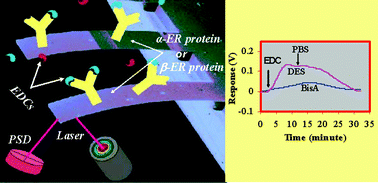A nanomechanical transducer is developed to detect and screen endocrine disrupting chemicals (EDCs) combining fluidic sample injection and delivery with bioreceptor protein functionalized microcantilevers (MCs). The adverse affects of EDCs on the endocrine system of humans, livestock, and wildlife provides strong motivation for advances in analytical detection and monitoring techniques. The combination of protein receptors, which include estrogen receptor alpha (ER-α) and estrogen receptor beta (ER-β), as well as monoclonal antibodies (Ab), with MC systems employing modified nanostructured surfaces provides for excellent nanomechanical response sensitivity and the inherent selectivity of biospecific receptor–EDC interactions. The observed ranking of binding interaction of the tested EDCs with ER-β is diethylstilbestrol (DES) > 17-β-estradiol > 17-α-estradiol > 2-OH-estrone > bisphenol A > p,p′-dichlorodiphenyldichloroethylene (p,p′-DDE) with measurements exhibiting intra-day RSDs of about 3%. A comparison of responses of three EDCs, which include 17-β-estradiol, 17-α-estradiol, and 2-OH-estrone, with ER-β and ER-α illustrates which estrogen receptor subtype provides the greatest sensitivity. Antibodies specific to a particular EDC can also be used for analyte specific screening. Calibration plots for a MC functionalized with anti-17-β-estradiol Ab show responses in the range of 1 × 10−11 through 1 × 10−7 M for 17-β-estradiol with a linear portion extending over two orders of magnitude in concentration.

You have access to this article
 Please wait while we load your content...
Something went wrong. Try again?
Please wait while we load your content...
Something went wrong. Try again?


 Please wait while we load your content...
Please wait while we load your content...